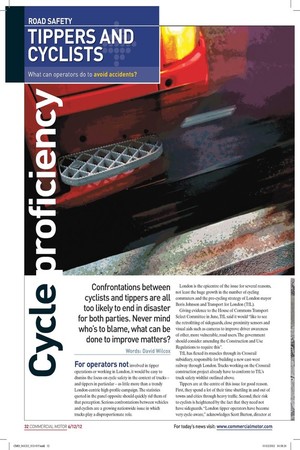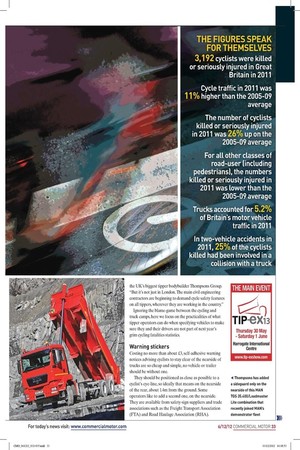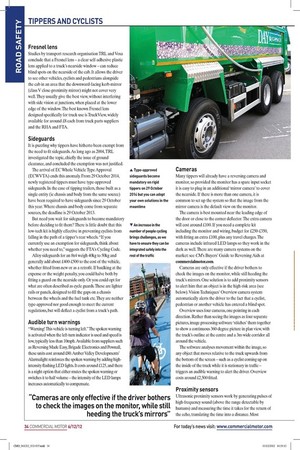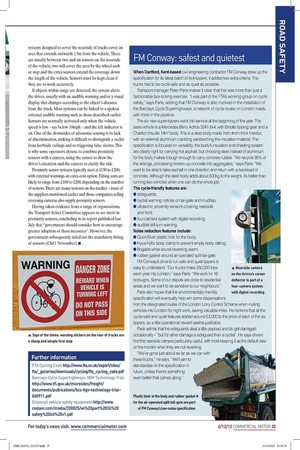Confrontations between cyclists and tippers are al
Page 24

Page 25

Page 26

Page 27

If you've noticed an error in this article please click here to report it so we can fix it.
Confrontations between cyclists and tippers are all too likely to end in disaster for both parties. Never mind who's to blame, what can be done to improve matters?
Words: David Wilcox For operators not involved in tipper operations or working in London, it would be easy to dismiss the focus on cycle safety in the context of trucks — and tippers in particular — as little more than a trendy London-centric high-profile campaign. The statistics quoted in the panel opposite should quickly rid them of that perception. Serious confrontations between vehicles and cyclists are a growing nationwide issue in which trucks play a disproportionate role.
London is the epicentre of the issue for several reasons, not least the huge growth in the number of cycling commuters and the pro-cycling strategy of London mayor Boris Johnson and Transport for London (TfL).
Giving evidence to the House of Commons Transport Select Committee in June, TfL said it would "like to see the retrofitting of sideguards, close proximity sensors and visual aids such as cameras to improve driver awareness of other, more vulnerable, road users. The government should consider amending the Construction and Use Regulations to require this".
TfL has flexed its muscles through its Crossrail subsidiary, responsible for building a new east-west railway through London. Trucks working on the Crossrail construction project already have to conform to TfL's truck safety wishlist outlined above.
Tippers are at the centre of this issue for good reason. First, they spend a lot of their time shuttling in and out of towns and cities through heavy traffic. Second, their risk to cyclists is heightened by the fact that they need not have sideguards. "London tipper operators have become very cycle-aware," acknowledges Scott Burton, director at the UK's biggest tipper bodybuilder Thompsons Group. "But it's not just in London. The main civil engineering contractors are beginning to demand cycle safety features on all tippers, wherever they are working in the country."
Ignoring the blame-game between the cycling and truck camps, here we focus on the practicalities of what tipper operators can do when specifying vehicles to make sure they and their drivers are not part of next year's grim cycling fatalities statistics.
Warning stickers Costing no more than about £3, self-adhesive warning notices advising cyclists to stay clear of the nearside of trucks are so cheap and simple, no vehicle or trailer should be without one.
They should be positioned as close as possible to a cyclist's eye-line, so ideally that means on the nearside of the rear, about 1.4m from the ground. Some operators like to add a second one, on the nearside. They are available from safety-sign suppliers and trade associations such as the Freight Transport Association (FTA) and Road Haulage Association (RHA).
Fresnel lens Studies by transport research organisation TRL and Vosa conclude that a Fresnel lens — a clear self-adhesive plastic lens applied to a truck's nearside window — can reduce blind spots on the nearside of the cab. It allows the driver to see other vehicles, cyclists and pedestrians alongside the cab in an area that the downward-facing kerb-mirror (class V close-proximity mirror) might not cover very well. They usually give the best view, without interfering with side vision at junctions, when placed at the lower edge of the window. The best known Fresnel lens designed specifically for truck use is TruckView, widely available for around £8 each from truck parts suppliers and the RHA and FTA.
Sideguards It is puzzling why tippers have hitherto been exempt from the need to fit sideguards. As long ago as 2004, TRL investigated the topic, chiefly the issue of ground clearance, and concluded the exemption was not justified.
The arrival of EC Whole Vehicle Type Approval (ECWVTA) ends this anomaly. From 29 October 2014, newly registered tippers must have type-approved sideguards. In the case of tipping trailers, those built as a single entity (ie chassis and body from the same source) have been required to have sideguards since 29 October this year. Where chassis and body come from separate sources, the deadline is 29 October 2013.
But need you wait for sideguards to become mandatory before deciding to fit them? There is little doubt that this low-tech kit is highly effective in preventing cyclists from falling in the path of a tipper's rear wheels. "If you currently use an exemption for sideguards, think about whether you need to," suggests the FTA's Cycling Code.
Alloy sideguards for an 8x4 weigh 40kg to 50kg and generally add about £400-£500 to the cost of the vehicle, whether fitted from new or as a retrofit. If baulking at the expense or the weight penalty, you could halve both by fitting a guard on the nearside only. Or you could opt for what are often described as cycle guards. These are lighter rails or panels, designed to fill the gaps on a chassis between the wheels and the fuel tank etc. They are neither type-approved nor good enough to meet the current regulations, but will deflect a cyclist from a truck's path.
Audible turn warnings "Warning! This vehicle is turning left." The spoken warning is activated when the left-turn indicator is used and speed is low, typically less than lOmph. Available from suppliers such as Reversing Made Easy, Brigade Electronics and Pownall, these units cost around £80. Amber Valley Developments' Alarmalight reinforces the spoken warning by adding highintensity flashing LED lights. It costs around £125, and there is a night option that either mutes the spoken warning or switches it to half volume — the intensity of the LED lamps increases automatically to compensate.
Cameras Many tippers will already have a reversing camera and monitor, so provided the monitor has a spare input socket it is easy to plug in an additional 'mirror camera' to cover the nearside. If there is more than one camera, it is common to set up the system so that the image from the mirror camera is the default view on the monitor.
The camera is best mounted near the leading edge of the door or close to the corner deflector. The extra camera will cost around £100. If you need a complete kit including the monitor and wiring, budget for £250-£350, with fitting an extra £100, plus any travel charges. The cameras include infrared LED lamps so they work in the dark as well. There are many camera systems on the market: see CM's Buyers' Guide to Reversing Aids at conunercialmotor.com.
Cameras are only effective if the driver bothers to check the images on the monitor, while still heeding the truck's mirrors. One solution is to add proximity sensors to alert him that an object is in the high-risk area (see below). Vision Techniques' Overview camera system automatically alerts the driver to the fact that a cyclist, pedestrian or another vehicle has entered a blind spot.
Overview uses four cameras, one pointing in each direction. Rather than seeing the images as four separate pictures, image processing software 'stitches' them together to show a continuous 360-degree picture in plan view, with the truck's outline at the centre and a 3m-wide corridor all around the vehicle.
The software analyses movement within the image, so any object that moves relative to the truck upwards from the bottom of the screen — such as a cyclist coming up on the inside of the truck while it is stationary in traffic — triggers an audible warning to alert the driver. Overview costs around £2,500 fitted.
Proximity sensors Ultrasonic proximity sensors work by generating pulses of high-frequency sound (above the range detectable by humans) and measuring the time it takes for the return of the echo, translating the time into a distance. Most systems designed to cover the nearside of trucks cover an area that extends outwards 1.5m from the vehicle. There are usually between two and six sensors on the nearside of the vehicle; two will cover the area by the wheel-arch or step and the extra sensors extend the coverage down the length of the vehicle. Sensors must be kept clean if they are to work accurately.
If objects within range are detected, the system alerts the driver, usually with an audible warning and/or a visual display that changes according to the object's distance from the truck. Most systems can be linked to a spoken external audible warning such as those described earlier. Sensors are normally activated only when the vehicle speed is low — say below 10mph — and the left indicator is on. One of the downsides of ultrasonic sensing is its lack of discrimination, making it difficult to distinguish a cyclist from kerbside railings and so triggering false alarms. This is why some operators choose to combine proximity sensors with a camera, using the sensor to draw the driver's attention and the camera to clarify the risk.
Proximity sensor systems typically start at £150 to £200, with external warnings an extra-cost option. Fitting costs are likely to range from £100 to £200, depending on the number of sensors. There are many systems on the market — most of the suppliers mentioned earlier and those companies selling reversing cameras also supply proximity sensors.
Having taken evidence from a range of organisations, the Transport Select Committee appears to see merit in proximity sensors, concluding in its report published last July that "government should consider how to encourage greater adoption of these measures". However, the government subsequently ruled out the mandatory fitting of sensors (CM1 November). • THE FIGURES SPEAK FOR THEMSELVES 3,192 cyclists were killed or seriously injured in Great Britain in 2011 Cycle traffic in 2011 was 11% higher than the 2005-09 average The number of cyclists killed or seriously injured in 2011 was 26% up on the 2005-09 average For all other classes of road-user (including pedestrians), the numbers killed or seriously injured in 2011 was lower than the 2005-09 average Trucks accounted for of Britain's motor vehicle traffic in 2011 In two-vehicle accidents in 2011, of the cyclists killed had been involved in a collision with a truck FM Conway: safest and quietest When Dartford, Kent-based civil engineering contractor FM Conway drew up the specification for its latest batch of 8x4 tippers, it added two extra criteria. The trucks had to be cycle-safe and as quiet as possible.
Transport manager Peter Parle makes it clear that this was more than just a fashionable box-ticking exercise. "I was part of the FTA's working group on cycle safety," says Parle, adding that FM Conway is also involved in the installation of the Barclays Cycle Superhighways, a network of cycle routes on London roads, with more in the pipeline.
The six new super-tippers went into service at the beginning of the year. The base vehicle is a Mercedes-Benz Actros 3241 8x4, with Binotto tipping gear and a Charlton Insulite 14m3 body. This is a steel body made from 4mm-thick Hardox, with an external aluminium cladding sandwiching the insulation material. The specification is focused on versatility: the body's insulation and sheeting system are clearly right for carrying hot asphalt, but choosing steel instead of aluminium for the body makes it tough enough to carry concrete rubble. "We recycle 95% of the arisings, processing broken-up concrete into aggregates," says Parle. "We want to be able to take asphalt in one direction and return with a backload of concrete. Although the steel body adds about 500kg to the weight, it's better than running two vehicles when one can do the whole job." The cycle-friendly features are: • sideguards; • cyclist warning notices on tail-gate and mudflap; • ultrasonic proximity sensors covering nearside and front; • four-camera system with digital recording; • audible left-turn warning. Noise reduction features include: • QuickSilver plastic liner for the body; • Hyva Hyf ix body clamp to prevent empty body rattling; • Brigade white sound reversing alarm; • rubber gasket around air-operated split tail-gate.
FM Conway's drive to run safe and quiet tippers is easy to understand. "Our trucks make 250,000 trips each year into London," says Parle. "We work for 16 boroughs. Some of our depots are close to residential areas and we want to be sensitive to our neighbours."
Parle also hopes that the environmentally-friendly specification will eventually help win some dispensations from the designated routes of the London Lorry Control Scheme when routing vehicles into London for night work, saving valuable miles. He reckons that all the cycle-safe and quiet features added around £3,000 to the price of each of the six tippers, so a little operational reward seems justifiable.
Parle admits that the sideguards steal a little payload and do get damaged occasionally— "but I'd rather damage a sideguard than a cyclist". He says drivers find the nearside camera particularly useful, with most keeping it as the default view on the monitor when they are not reversing.
"We've gone just about as far as we can with these trucks," he says. "We'll aim to standardise on the specification in future, unless there's something even better that comes along."
A Nearside camera on the Actros's corner deflector is part of a four-camera system with digital recording Further information FTA Cycling Code http://www.fta.co.uk/export/sites/ ftaLgalleries/downloadacycling/fta_cycling_code.pdf Barclays Cycle Superhighways: HGV Technology Trial http://www.tfl.gov.uk/microsites/freight/ documents/publications/bcs-hgv-technology-trial- 060911.pdf Crossrail vehicle safety equipment http://www. costain.com/med ia/330025MP/020part%2026%20 safetr/020kitY020v1.pdf








































